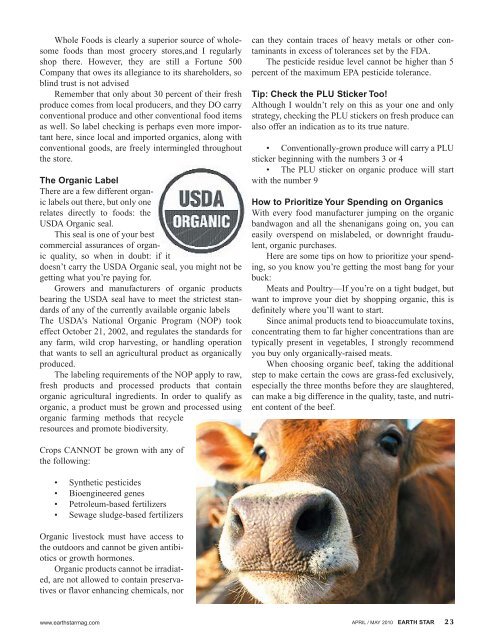Earth Star Magazine Online - Issue #193 April/May'10
Earth Star Magazine Online - Issue #193 April/May'10
Earth Star Magazine Online - Issue #193 April/May'10
- No tags were found...
You also want an ePaper? Increase the reach of your titles
YUMPU automatically turns print PDFs into web optimized ePapers that Google loves.
Whole Foods is clearly a superior source of wholesomefoods than most grocery stores,and I regularlyshop there. However, they are still a Fortune 500Company that owes its allegiance to its shareholders, soblind trust is not advisedRemember that only about 30 percent of their freshproduce comes from local producers, and they DO carryconventional produce and other conventional food itemsas well. So label checking is perhaps even more importanthere, since local and imported organics, along withconventional goods, are freely intermingled throughoutthe store.The Organic LabelThere are a few different organiclabels out there, but only onerelates directly to foods: theUSDA Organic seal.This seal is one of your bestcommercial assurances of organicquality, so when in doubt: if itdoesn’t carry the USDA Organic seal, you might not begetting what you’re paying for.Growers and manufacturers of organic productsbearing the USDA seal have to meet the strictest standardsof any of the currently available organic labelsThe USDA’s National Organic Program (NOP) tookeffect October 21, 2002, and regulates the standards forany farm, wild crop harvesting, or handling operationthat wants to sell an agricultural product as organicallyproduced.The labeling requirements of the NOP apply to raw,fresh products and processed products that containorganic agricultural ingredients. In order to qualify asorganic, a product must be grown and processed usingorganic farming methods that recycleresources and promote biodiversity.can they contain traces of heavy metals or other contaminantsin excess of tolerances set by the FDA.The pesticide residue level cannot be higher than 5percent of the maximum EPA pesticide tolerance.Tip: Check the PLU Sticker Too!Although I wouldn’t rely on this as your one and onlystrategy, checking the PLU stickers on fresh produce canalso offer an indication as to its true nature.• Conventionally-grown produce will carry a PLUsticker beginning with the numbers 3 or 4• The PLU sticker on organic produce will startwith the number 9How to Prioritize Your Spending on OrganicsWith every food manufacturer jumping on the organicbandwagon and all the shenanigans going on, you caneasily overspend on mislabeled, or downright fraudulent,organic purchases.Here are some tips on how to prioritize your spending,so you know you’re getting the most bang for yourbuck:Meats and Poultry—If you’re on a tight budget, butwant to improve your diet by shopping organic, this isdefinitely where you’ll want to start.Since animal products tend to bioaccumulate toxins,concentrating them to far higher concentrations than aretypically present in vegetables, I strongly recommendyou buy only organically-raised meats.When choosing organic beef, taking the additionalstep to make certain the cows are grass-fed exclusively,especially the three months before they are slaughtered,can make a big difference in the quality, taste, and nutrientcontent of the beef.Crops CANNOT be grown with any ofthe following:• Synthetic pesticides• Bioengineered genes• Petroleum-based fertilizers• Sewage sludge-based fertilizersOrganic livestock must have access tothe outdoors and cannot be given antibioticsor growth hormones.Organic products cannot be irradiated,are not allowed to contain preservativesor flavor enhancing chemicals, norwww.earthstarmag.com APRIL / MAY 2010 EARTH STAR 23
















